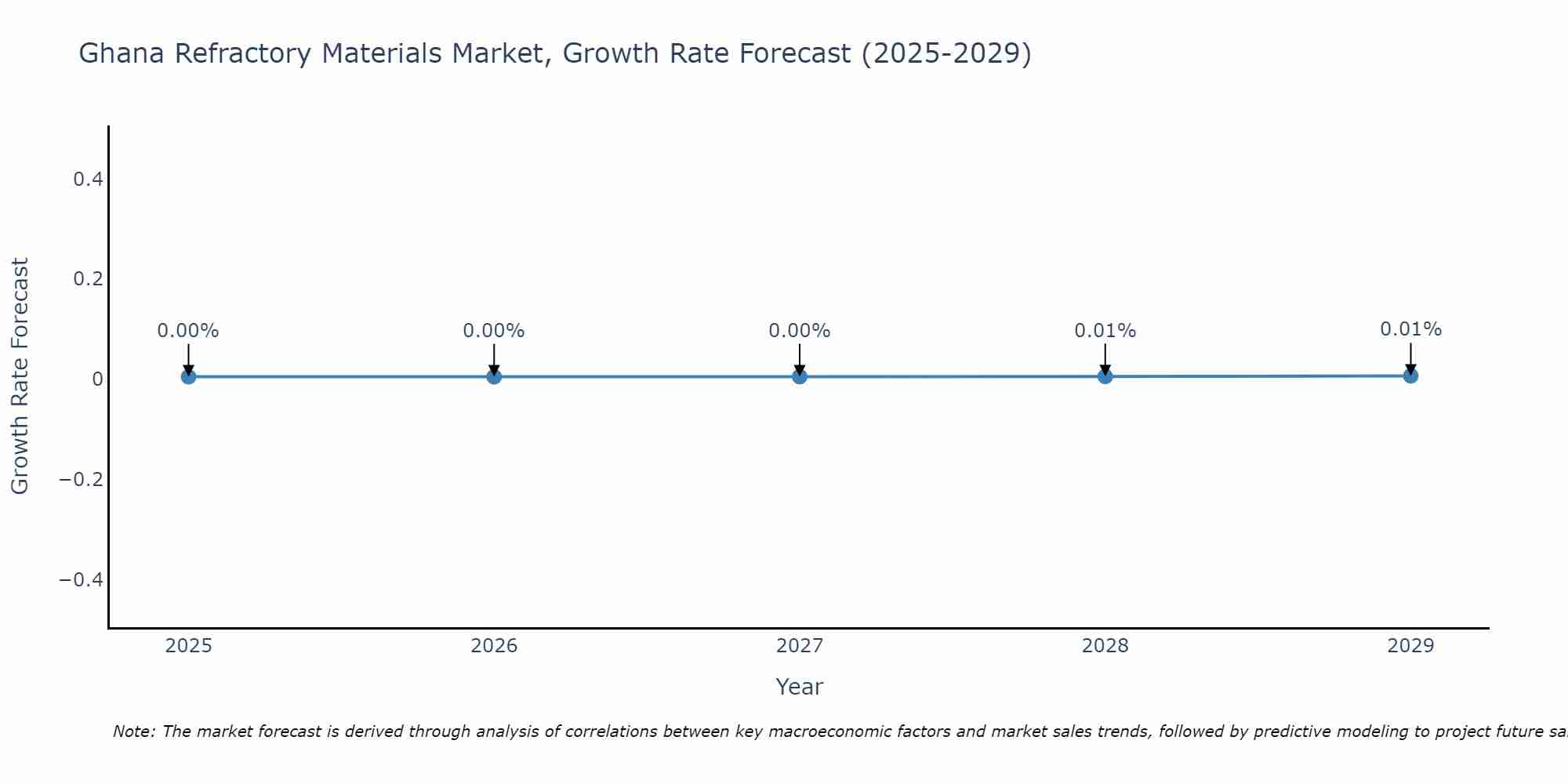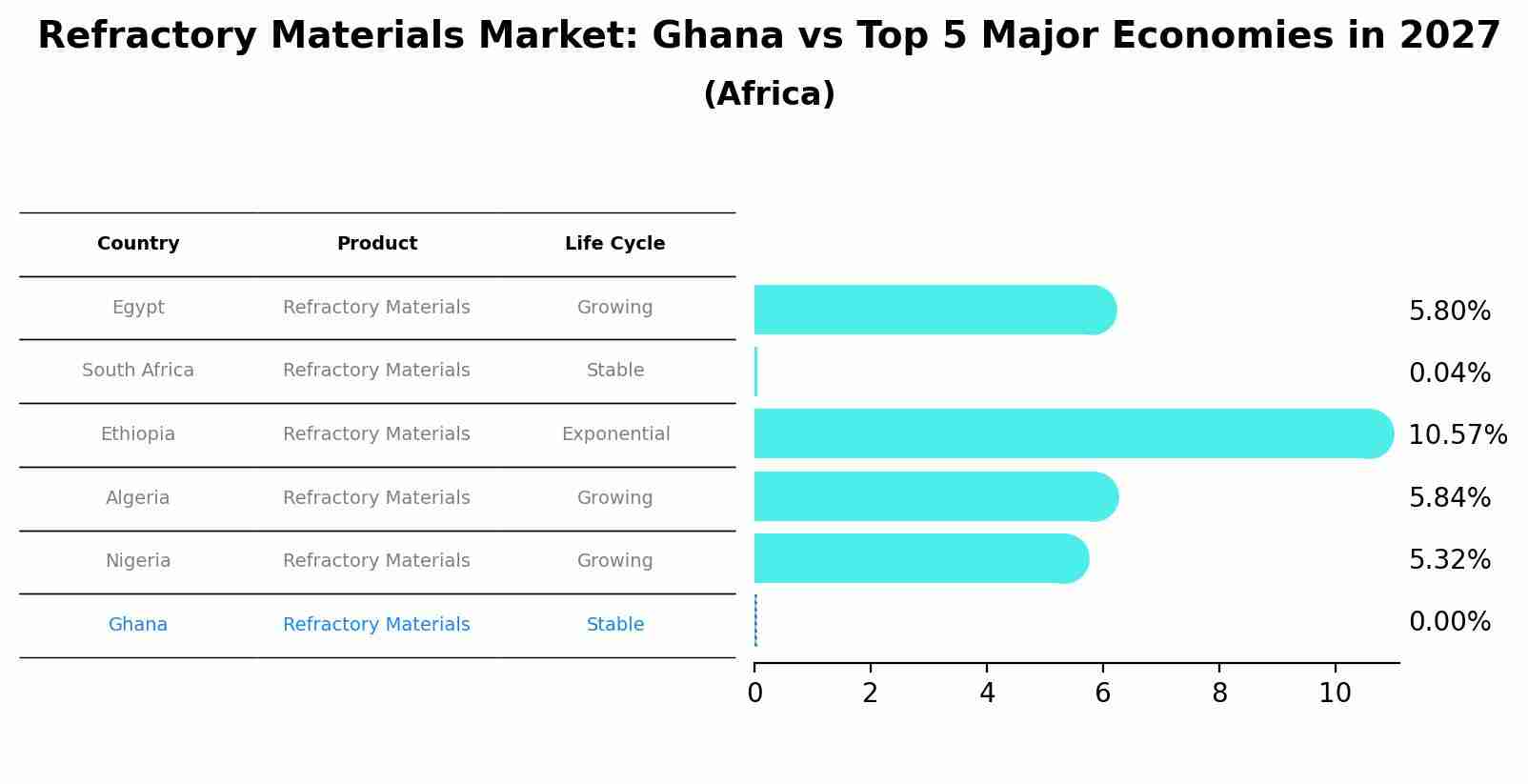Ghana Refractory Materials Market (2025-2031) | Share, Outlook, Industry, Trends, Value, Companies, Analysis, Growth, Size, Forecast & Revenue
| Product Code: ETC033676 | Publication Date: Oct 2020 | Updated Date: Jun 2025 | Product Type: Report | |
| Publisher: 6Wresearch | Author: Shubham Padhi | No. of Pages: 70 | No. of Figures: 35 | No. of Tables: 5 |
Ghana Refractory Materials Market Size Growth Rate
The Ghana Refractory Materials Market is poised for steady growth rate improvements from 2025 to 2029. From 0.00% in 2025, the growth rate steadily ascends to 0.01% in 2029.

Refractory Materials Market: Ghana vs Top 5 Major Economies in 2027 (Africa)
The Refractory Materials market in Ghana is projected to grow at a stable growth rate of 0.00% by 2027, highlighting the country's increasing focus on advanced technologies within the Africa region, where Egypt holds the dominant position, followed closely by South Africa, Ethiopia, Algeria and Nigeria, shaping overall regional demand.

Ghana Refractory Materials Market Overview
The Ghana refractory materials market is experiencing steady growth driven by increasing industrial activities in sectors such as mining, cement production, and metal processing. The demand for refractory materials in Ghana is primarily fueled by the need to withstand high temperatures and harsh operating conditions in these industries. The market is characterized by a mix of local manufacturers and international suppliers offering a range of products such as bricks, cement, ceramics, and castables. Key factors influencing the market include infrastructure development, technological advancements, and increasing demand for high-quality refractory materials to enhance operational efficiency and prolong equipment lifespan. As the industrial sector in Ghana continues to expand, the refractory materials market is expected to witness further growth opportunities in the coming years.
Ghana Refractory Materials Market Trends
The Ghana Refractory Materials Market is experiencing a growing demand due to the expanding industrial sector in the country. Key trends include a shift towards sustainable and eco-friendly refractory materials to align with global environmental regulations. Additionally, there is a rising adoption of advanced refractory technologies to enhance operational efficiency and reduce maintenance costs for industries such as steel, cement, and glass manufacturing. Market players are focusing on product innovation and customization to meet the specific requirements of different end-user industries. Increased investments in infrastructure development and construction projects in Ghana are driving the demand for refractory materials, presenting opportunities for market growth. Overall, the market is witnessing a trend towards high-performance and durable refractory solutions to withstand the challenging operating conditions in various industrial processes.
Ghana Refractory Materials Market Challenges
In the Ghana refractory materials market, challenges include limited access to high-quality raw materials, inconsistent power supply leading to production interruptions, and a lack of skilled labor in specialized refractory manufacturing techniques. Additionally, the market faces competition from cheaper imported products, which can hinder the growth of local manufacturers. Infrastructure constraints, such as poor transportation networks and limited warehousing facilities, also impact the distribution of refractory materials within the country. To overcome these challenges, companies in the Ghana refractory materials market need to invest in technology upgrades, establish strategic partnerships with international suppliers, and focus on developing the local workforce`s skills to enhance product quality and competitiveness in the market.
Ghana Refractory Materials Market Investment Opportunities
The Ghana refractory materials market presents promising investment opportunities driven by the country`s growing industrial sector and increasing demand for high-quality refractory products. With sectors such as mining, steel, cement, and glass showing steady growth, there is a rising need for refractory materials to withstand high temperatures and harsh conditions in manufacturing processes. Investing in the production or distribution of refractory materials in Ghana can be lucrative, especially considering the country`s stable political environment and strategic location within West Africa. Additionally, with ongoing infrastructure development projects and the government`s support for industrialization, the demand for refractory materials is expected to further rise, making it a favorable sector for potential investors looking for long-term growth prospects in Ghana`s industrial landscape.
Ghana Refractory Materials Market Government Policy
The Ghanaian government has implemented various policies to support the refractory materials market, including the promotion of local manufacturing to reduce reliance on imports. The government has also provided incentives such as tax breaks and subsidies to encourage investment in the sector, aiming to boost domestic production and create employment opportunities. Additionally, there are regulations in place to ensure the quality and standards of refractory materials, with periodic inspections and certifications required for manufacturers. The government`s focus on developing the refractory materials market aligns with its broader industrialization agenda, aiming to enhance the competitiveness of local industries and contribute to economic growth and sustainability in Ghana.
Ghana Refractory Materials Market Future Outlook
The Ghana refractory materials market is poised for steady growth in the coming years due to increasing industrialization and infrastructure development in the country. The demand for refractory materials, crucial for high-temperature applications in industries such as steel, cement, and glass manufacturing, is expected to rise as these sectors expand. Additionally, the government`s focus on promoting local manufacturing and attracting foreign investment is likely to drive further demand for refractory products. With Ghana`s economy projected to grow and diversify, the refractory materials market is anticipated to witness a positive trajectory, presenting opportunities for both domestic manufacturers and international suppliers to cater to the growing needs of the industrial sector in the country.
Key Highlights of the Report:
- Ghana Refractory Materials Market Outlook
- Market Size of Ghana Refractory Materials Market, 2024
- Forecast of Ghana Refractory Materials Market, 2026
- Historical Data and Forecast of Ghana Refractory Materials Revenues & Volume for the Period 2021 - 2031
- Ghana Refractory Materials Market Trend Evolution
- Ghana Refractory Materials Market Drivers and Challenges
- Ghana Refractory Materials Price Trends
- Ghana Refractory Materials Porter's Five Forces
- Ghana Refractory Materials Industry Life Cycle
- Historical Data and Forecast of Ghana Refractory Materials Market Revenues & Volume By Type for the Period 2021 - 2031
- Historical Data and Forecast of Ghana Refractory Materials Market Revenues & Volume By Brick for the Period 2021 - 2031
- Historical Data and Forecast of Ghana Refractory Materials Market Revenues & Volume By Monolithic for the Period 2021 - 2031
- Historical Data and Forecast of Ghana Refractory Materials Market Revenues & Volume By Applications for the Period 2021 - 2031
- Historical Data and Forecast of Ghana Refractory Materials Market Revenues & Volume By Clay Refractories for the Period 2021 - 2031
- Historical Data and Forecast of Ghana Refractory Materials Market Revenues & Volume By Non-clay Refractories for the Period 2021 - 2031
- Ghana Refractory Materials Import Export Trade Statistics
- Market Opportunity Assessment By Type
- Market Opportunity Assessment By Applications
- Ghana Refractory Materials Top Companies Market Share
- Ghana Refractory Materials Competitive Benchmarking By Technical and Operational Parameters
- Ghana Refractory Materials Company Profiles
- Ghana Refractory Materials Key Strategic Recommendations
Frequently Asked Questions About the Market Study (FAQs):
1 Executive Summary |
2 Introduction |
2.1 Key Highlights of the Report |
2.2 Report Description |
2.3 Market Scope & Segmentation |
2.4 Research Methodology |
2.5 Assumptions |
3 Ghana Refractory Materials Market Overview |
3.1 Ghana Country Macro Economic Indicators |
3.2 Ghana Refractory Materials Market Revenues & Volume, 2019 & 2026F |
3.3 Ghana Refractory Materials Market - Industry Life Cycle |
3.4 Ghana Refractory Materials Market - Porter's Five Forces |
3.5 Ghana Refractory Materials Market Revenues & Volume Share, By Type, 2021 & 2031F |
3.6 Ghana Refractory Materials Market Revenues & Volume Share, By Applications, 2019 & 2026F |
4 Ghana Refractory Materials Market Dynamics |
4.1 Impact Analysis |
4.2 Market Drivers |
4.3 Market Restraints |
5 Ghana Refractory Materials Market Trends |
6 Ghana Refractory Materials Market, By Types |
6.1 Ghana Refractory Materials Market, By Type |
6.1.1 Overview and Analysis |
6.1.2 Ghana Refractory Materials Market Revenues & Volume, By Type, 2016 - 2026F |
6.1.3 Ghana Refractory Materials Market Revenues & Volume, By Brick, 2016 - 2026F |
6.1.4 Ghana Refractory Materials Market Revenues & Volume, By Monolithic, 2016 - 2026F |
6.2 Ghana Refractory Materials Market, By Applications |
6.2.1 Overview and Analysis |
6.2.2 Ghana Refractory Materials Market Revenues & Volume, By Clay Refractories, 2016 - 2026F |
6.2.3 Ghana Refractory Materials Market Revenues & Volume, By Non-clay Refractories, 2016 - 2026F |
7 Ghana Refractory Materials Market Import-Export Trade Statistics |
7.1 Ghana Refractory Materials Market Export to Major Countries |
7.2 Ghana Refractory Materials Market Imports from Major Countries |
8 Ghana Refractory Materials Market Key Performance Indicators |
9 Ghana Refractory Materials Market - Opportunity Assessment |
9.1 Ghana Refractory Materials Market Opportunity Assessment, By Type, 2019 & 2026F |
9.2 Ghana Refractory Materials Market Opportunity Assessment, By Applications, 2019 & 2026F |
10 Ghana Refractory Materials Market - Competitive Landscape |
10.1 Ghana Refractory Materials Market Revenue Share, By Companies, 2024 |
10.2 Ghana Refractory Materials Market Competitive Benchmarking, By Operating and Technical Parameters |
11 Company Profiles |
12 Recommendations |
13 Disclaimer |
- Single User License$ 1,995
- Department License$ 2,400
- Site License$ 3,120
- Global License$ 3,795
Search
Thought Leadership and Analyst Meet
Our Clients
Related Reports
- Germany Breakfast Food Market (2026-2032) | Industry, Share, Growth, Size, Companies, Value, Analysis, Revenue, Trends, Forecast & Outlook
- Australia Briquette Market (2025-2031) | Growth, Size, Revenue, Forecast, Analysis, Trends, Value, Share, Industry & Companies
- Vietnam System Integrator Market (2025-2031) | Size, Companies, Analysis, Industry, Value, Forecast, Growth, Trends, Revenue & Share
- ASEAN and Thailand Brain Health Supplements Market (2025-2031) | Strategy, Consumer Insights, Analysis, Investment Trends, Opportunities, Growth, Size, Share, Industry, Revenue, Segments, Value, Segmentation, Supply, Forecast, Restraints, Outlook, Competition, Drivers, Trends, Demand, Pricing Analysis, Competitive, Strategic Insights, Companies, Challenges
- ASEAN Bearings Market (2025-2031) | Strategy, Consumer Insights, Analysis, Investment Trends, Opportunities, Growth, Size, Share, Industry, Revenue, Segments, Value, Segmentation, Supply, Forecast, Restraints, Outlook, Competition, Drivers, Trends, Demand, Pricing Analysis, Competitive, Strategic Insights, Companies, Challenges
- Europe Flooring Market (2025-2031) | Outlook, Share, Industry, Trends, Forecast, Companies, Revenue, Size, Analysis, Growth & Value
- Saudi Arabia Manlift Market (2025-2031) | Outlook, Size, Growth, Trends, Companies, Industry, Revenue, Value, Share, Forecast & Analysis
- Uganda Excavator, Crane, and Wheel Loaders Market (2025-2031) | Strategy, Consumer Insights, Analysis, Investment Trends, Opportunities, Growth, Size, Share, Industry, Revenue, Segments, Value, Segmentation, Supply, Forecast, Restraints, Outlook, Competition, Drivers, Trends, Demand, Pricing Analysis, Competitive, Strategic Insights, Companies, Challenges
- Rwanda Excavator, Crane, and Wheel Loaders Market (2025-2031) | Strategy, Consumer Insights, Analysis, Investment Trends, Opportunities, Growth, Size, Share, Industry, Revenue, Segments, Value, Segmentation, Supply, Forecast, Restraints, Outlook, Competition, Drivers, Trends, Demand, Pricing Analysis, Competitive, Strategic Insights, Companies, Challenges
- Kenya Excavator, Crane, and Wheel Loaders Market (2025-2031) | Strategy, Consumer Insights, Analysis, Investment Trends, Opportunities, Growth, Size, Share, Industry, Revenue, Segments, Value, Segmentation, Supply, Forecast, Restraints, Outlook, Competition, Drivers, Trends, Demand, Pricing Analysis, Competitive, Strategic Insights, Companies, Challenges
Industry Events and Analyst Meet
Whitepaper
- Middle East & Africa Commercial Security Market Click here to view more.
- Middle East & Africa Fire Safety Systems & Equipment Market Click here to view more.
- GCC Drone Market Click here to view more.
- Middle East Lighting Fixture Market Click here to view more.
- GCC Physical & Perimeter Security Market Click here to view more.
6WResearch In News
- Doha a strategic location for EV manufacturing hub: IPA Qatar
- Demand for luxury TVs surging in the GCC, says Samsung
- Empowering Growth: The Thriving Journey of Bangladesh’s Cable Industry
- Demand for luxury TVs surging in the GCC, says Samsung
- Video call with a traditional healer? Once unthinkable, it’s now common in South Africa
- Intelligent Buildings To Smooth GCC’s Path To Net Zero


















